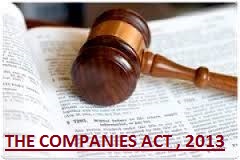Company is an artificial person created by law . It is voluntary association of group of people who are work together to achieve a specific objective. After registration, it has a separate legal entity means company is different from its member.
COMPANY ACT (1956): company act describe the rules and regulation that every company have to follow while come into existence. It provide rules regarding preparation of ARTICLE OF ASSOCIATION ,MEMORANDUM OF ASSOCIATION,PROSPECTUS, LIEU OF PROSPECTUS AND PREPARATION OF FINANCIAL ACCOUNTS AND RULES REGARDING THE FINANCIAL REPORT.
As per some situation as remove the loopholes of the law there are time to time amendments is going on.
Recently,2013 amendments is happened in company act. Now as per new act duty of auditor is increased. A big change happened in accounting. Company act do amendments in depreciation which is treated as non cash item in business charge on assets at a fixed rate.
AMENDMENTS IN DEPRECIATION PROCEDURE
Depreciation means decrease and fall in value of fixed assets, due to any reason .it may be normal wear and tear, accidental. It is treated as non cash item in financial accounting. Main purpose of charging depreciation help firm to preparation of reserve for new machinery and also tax benefit is there.
As per accounting standard 6,
Principle of consistency says that if a methods follow by firm should be consistent. it may be method of depreciation ,valuation of stock or valuation or goodwill etc.
But if company want to change in his method of accounting it can but it is necessary for company to represent information to register office and annual general meeting.
When company do so , at that time company has to transfer adjusted amount in profit and loss account. Amount is the difference of methods changing by company.
AS per company act 2013 , schedule II, the term depreciation include amortization.
The useful life of an assets shall not be longer than useful life specified in part ’c’ and residual value of assets shall not be more than five percent of original cost on an assets, provided that where a company uses a useful life or residual value of assets which is different from the above limit, justification for difference shall be disclosed in the financial statement.
Intangible assets: Provision as per accounting standard for time being in force shall apply except in case of intangible assets (toll roads) create under build operate and transfer , ‘build, own, operate and transfer’ or any other form of public private partnership route in case of road map.
Amortization in such cases may be done as follows:
Modes of amortization: amortization amount/cost of intangible assets
Amortization amount= actual revenue for the year/projected Revenue from intangible assets (till the end of the concession period)
Click here for government certification in Accounting, Banking & Finance





4 Comments. Leave new
informative 🙂
good job Garima 🙂
These amendments are the need of the hour and will help India to be in synchronization with the inter nation accounting principals.
Informative article.. good job..
Nice work